by Kenan White | Mar 15, 2010 | Exploring, Flowers, Growing, Herbs, Life on the Farm, Miscellaneous |
Returning from vacation is usually not something one looks forward to. It marks the end of the trip that you have been waiting so long to take. All the months that you spent planning, preparing, and getting everything in place seems like a distant memory now. As sad as this idea is, all good things must come to an end. If you don’t finish one vacation, how can you take another? Surely you have been dreaming of the day you can jump on a private jet, that you have hired through a company like Jettly, and travel to the likes of New York, London, Paris, and lots of other different countries and cities? Taking trips like this is what life is all about, and just think about all of the memories and stories that you’ll come back with. That alone must be enough to persuade you to take another vacation as soon as possible.
In the meantime, adjusting to the normality of your life is something that you’re going to have to focus on for now. With that being said, leaving plants in the greenhouse does leave something worth returning to. Walking into the greenhouse this morning, I was stunned to see how much all of my herb plants and flowering annuals had grown. Just look at the picture and see that our plants are ready for spring.
The basil plant had grown a full inch and the leaf buds are popping on the bay leaf plants! Spring is almost here, whether herb gardening or growing flowers and veggies this year the time to get started in now! Besides the plants, the rest of my job was about like average. Start thinking about your garden and let The Growers- Exchange.com help get your spring started.
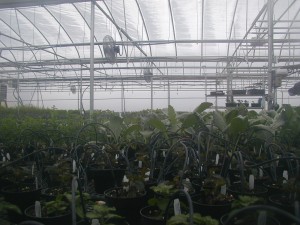
by Briscoe White | Mar 3, 2010 | Exploring, Flowers, Gardening, Growing, Life on the Farm, Wildlife |
Last fall when I first began this gardening blog, I reported on my seed collecting endeavors. Seed collecting is just the first step towards growing plants. All those ziplock bags full of seeds were carefully stored over the winter.
And now we are at the next step, which is to plant the seeds. I had collected seeds from various flowering annuals, some perennials, and a few herb plants. The goal is to plant wildflowers in all the conservation grasslands around the farm. Annual plants such as cosmos and Gomphrena will give color this year as the perennial natives establish themselves. To create a blooming prairie effect Dames Rocket and Shasta Daisies start blooming in spring and are followed by Coreopsis, Rudbeckia, Ratibida, and Echinacea in summer. A total of thirty types of flowers were planted
This year I am planting what I call “the grand finale”. Summer into fall will find Helianthus full of yellow sunflowers intermixed with the blue haze of wild Ageratum. I will have to wait until the following fall to see how it works, perennials must have time to establish. But for now we must wait and have faith that planting these seeds in the cold ground will sprout and grow in spring.
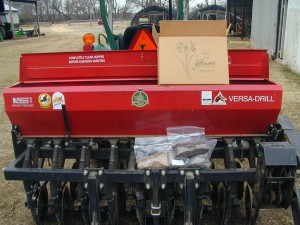
by Briscoe White | Feb 12, 2010 | Exploring, Life on the Farm, Miscellaneous |

We’re still riding out the storm(s), but look how well the plants are doing. They don’t even know it’s cold outside! See you next week!
by Briscoe White | Feb 8, 2010 | Exploring, Life on the Farm, Miscellaneous |
Once again we have survived a winter storm. Even though we were covered up with snow, then rain and sleet, and then some more snow we feel lucky. Because even though temperatures were down in the teens, the wind only blew for a short while. For us, this means the power lines did not go down. What a luxury! We do feel lucky!
All the little plants growing towards their ship dates never suffered temperatures below sixty degrees, though we did have to use both gas and wood heaters at times. This is a winter that doesn’t quit!! Those of us that stay on the farm during storms get used to an isolation that takes a few days to wear off.
Another storm is due tomorrow, so I guess we will stay in survival mode a few more days. It is hard to think about gardening right now. The ground is frozen and covered with ice, most days it is to cold to be outside for long. But as growers we know that spring is only a few weeks away, and if our customers are to be ready to plant we have to get these plants through to spring! So, Mother Nature, bring it on again. We will last it out knowing it will be over soon! Hope springs eternal, and I am sure hoping for spring
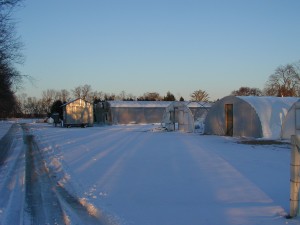
by Briscoe White | Feb 3, 2010 | Exploring, Life on the Farm, Miscellaneous |
We always believed our LP gas heaters helped us heat our greenhouses without much environmental damage. Over time we became convinced that burning wood is environmentally better than burning gas. It is hard to believe on the surface because the gas heater makes no exhaust you can see, they do not smell and do not need cleaning. The wood burner on the other hand is smoky and smelly, but is a fraction of the cost for gas. We also must tend to the wood stove several times through out the day, someone has to add those hundred pound logs.
Being tree lovers, we recognize different species as we throw logs to the fire. These trees were cut and on the way to the lumber and chip mills but purchased by us. Knowing they were cut anyway makes it bearable. The carbon released is already in the environment and therefore better than that released by fossil fuel. We also learned that LP gas escapes the system from the well head to pilot light, each molecule has twenty- four times the greenhouse effect as a carbon molecule. So we switched to wood heat last winter. It is a lot cheaper, but a lot of work. And we do hope, a more environmentally friendly option.
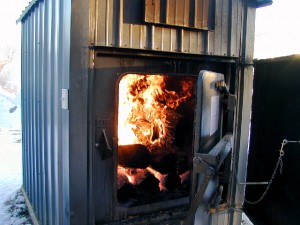
by Briscoe White | Feb 1, 2010 | Exploring, Life on the Farm, Miscellaneous |
It is hard not to comment on the weather when discussing the garden. Everything about it is weather dependent, including when the gardener wishes to garden. But when one has a greenhouse full of young plants like we do here, severe weather can become a real challenge.
The Growers Exchange greenhouse crew has pulled through yet another terrible winter storm. We burned several cords of wood and didn’t lose a single greenhouse! These winter storms isolate us and sometimes cut us off from the rest of the world. This last storm required four nights of vigilance to keep the young plants safe. There is always a chance that a large greenhouse may be affected quite badly by the storms, such as damaging or caving in the roof, depending on the severity of the storm. There are roof replacement Raleigh services, as well as many others in various areas, that can help replace a fully damaged roof, so your plants can go back to being their thriving selves.
The strangest part is when it is over and you drive off the farm into the real world, which is going on like the storm never happened. Sometimes I wonder if it is better to not be affected by weather or if all the stuff we go though is worth the effort. I realize, sad as it is, that some of my best adventures have been during these storms. They almost seem fun as they fade into history, somehow all the pains and tribulations are forgotten. When winter is over, we are all set to plant!
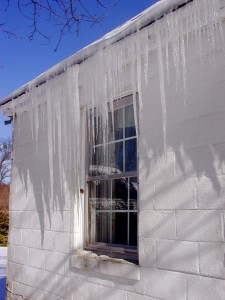
GIANT icicles outside of our offices.






